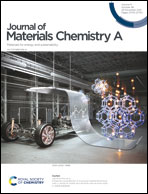Hierarchical microsphere MOF arrays with ultralow Ir doping for efficient hydrogen evolution coupled with hydrazine oxidation in seawater†
Abstract
The hydrogen evolution reaction (HER) based on water electrolysis is promising for renewable hydrogen production. Limited by the sluggish anodic oxygen evolution reaction (OER), rational fabrication of efficient catalysts for the HER coupled with the hydrazine oxidation reaction (HzOR) is tremendously important for energy-saving hydrogen production. Herein, we report a facile one-step approach to in situ grow microsphere-like Ir-doped Ni/Fe-based MOF arrays on nickel foam (MIL-(IrNiFe)@NF). Benefitting from the superior transfer coefficient and hierarchical structure, the as-obtained MIL-(IrNiFe)@NF electrocatalyst shows superb electrocatalytic activity and stability toward water splitting in alkaline media and a voltage of 1.9 V to achieve 1000 mA cm−2 is realized for overall seawater electrolysis. Moreover, combining this HER catalyst with the HzOR in seawater electrolysis, an ultralow voltage of 0.69 V is achieved at 1000 mA cm−2 and with excellent durability, demonstrating its great potential for efficient seawater electrolysis. This work affords a cost-efficient approach toward the fabrication of metal-doped MOFs for energy-saving water/seawater electrocatalysis.



 Please wait while we load your content...
Please wait while we load your content...